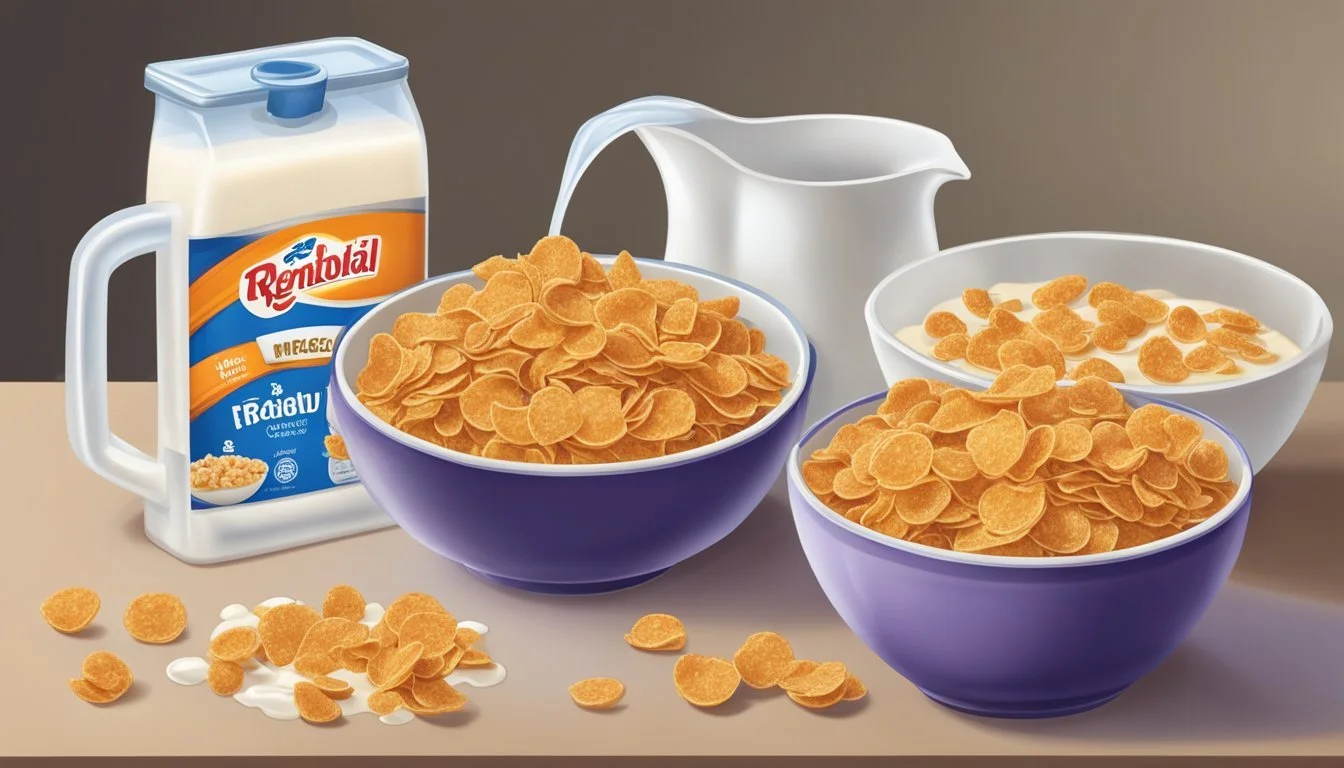Frosted Flakes vs Post Grape-Nut Flakes
Comparing Breakfast Cereal Choices
This Article is Part of Our Breakfast Cereal Guide with Details on Frosted Flakes Nutrition and Post GrapevsNut Flakes Nutrition
When choosing between Frosted Flakes and Post Grape-Nuts Flakes, it's essential to consider nutrition and taste to make an informed decision. Frosted Flakes tend to be higher in sugar and offer a sweeter, more indulgent breakfast option. In contrast, Post Grape-Nuts Flakes provide a heartier, more fiber-rich choice beneficial for those looking to enhance their dietary fiber intake.
Each cereal has unique attributes catering to different dietary needs and preferences. Frosted Flakes might appeal to those who enjoy a sugary start to their day, while Post Grape-Nuts Flakes can be a go-to for individuals prioritizing fiber and a moderate calorie count. By understanding these differences, readers can better align their cereal selection with their health objectives.
For many, the morning meal sets the tone for the rest of the day. Choosing a nutritious, fulfilling cereal can impact energy levels, satiety, and overall health. Balancing taste and nutritional value is crucial, and Post Grape-Nuts Flakes can offer a more balanced breakfast choice compared to Frosted Flakes.
Overview of the Cereal Market
The cereal market has evolved significantly since its inception, shaped by both historical milestones and present-day consumer preferences. This overview examines these aspects in detail.
Historical Context
Breakfast cereal emerged in the late 19th century, driven by innovations from figures like Dr. John Harvey Kellogg. Kellogg's Corn Flakes, for instance, dates back to 1894, when W.K. Kellogg and his brother accidentally discovered the process of flaking corn.
During the mid-20th century, cereals like Frosted Flakes entered the market, appealing to children with their sweet flavors. Post's Grape-Nuts offered a contrasting option, marketed for its health benefits.
Merging taste with nutrition became a trend, leading to an expanding variety of cereals.
Present-Day Cereal Landscape
Today, the cereal market is diverse, catering to different dietary needs and preferences. Consumers are more health-conscious, seeking options rich in protein and fiber, such as Grape-Nuts. Meanwhile, traditional favorites like Frosted Flakes remain popular due to their nostalgic value and taste.
The average unit price of cereals today hovers around $3.47. Brands continually innovate, responding to trends like gluten-free and organic products. Moreover, the rise of digital grocery shopping has influenced how cereals are marketed and purchased, making convenience a key factor for consumers.
Nutritional Comparison
This section explores the nutritional differences between Frosted Flakes and Post Grape-Nuts Flakes, focusing on caloric content, macronutrient profile, and vitamins and minerals.
Caloric Content
Frosted Flakes offer a straightforward calorie count of about 150 calories per cup. On the other hand, Post Grape-Nuts Flakes are slightly more calorie-dense, with approximately 200 calories per cup.
The specific calorie content can vary based on serving size, so it is crucial to pay attention to portion sizes on individual product labels. Despite both being cereals, the calorie difference may influence your choice depending on dietary goals.
Macronutrient Profile
Protein and Fiber:
Frosted Flakes: Minimal protein at 2 grams per serving and low fiber content.
Grape-Nuts Flakes: Higher in protein with 4 grams per serving and significant fiber at about 7 grams per serving.
Sugar and Carbohydrates:
Frosted Flakes: High sugar content at 13 grams per serving and 33 grams total carbohydrates.
Grape-Nuts Flakes: Lower in sugar with 5 grams per serving and higher in total carbohydrates due to increased fiber and complex carbs, contributing to roughly 37 grams per serving.
Vitamins and Minerals
Iron and Zinc:
Frosted Flakes: Contains around 4.5 mg of iron per serving.
Grape-Nuts Flakes: Comparable iron content at about 4 mg per serving, also good sources of zinc.
Vitamins:
Frosted Flakes: Rich in B-vitamins, including B6 and B12, critical for energy metabolism.
Grape-Nuts Flakes: Also packed with B-vitamins and includes vitamin C, which aids in iron absorption.
Calcium and Magnesium:
Frosted Flakes: Contains modest calcium and magnesium levels.
Grape-Nuts Flakes: Slightly higher in these minerals, making them more beneficial for bone health.
By comparing these two cereals in terms of calorie content, macronutrient profile, and their vitamin and mineral contributions, consumers can make a more informed decision based on nutritional needs and dietary goals.
Ingredient Analysis
When comparing Frosted Flakes and Post Grape-Nuts Flakes, it's crucial to analyze the ingredients. This section will focus on whole grains and fibers, added sugars and sweeteners, and preservatives and additives.
Whole Grains and Fibers
Frosted Flakes and Grape-Nuts Flakes differ significantly in their whole grain and fiber content. Grape-Nuts Flakes are known for their high whole grain and fiber content, which makes them a healthier option for digestive benefits. Each serving contains multiple grams of dietary fiber, essential for promoting digestion and maintaining healthy cholesterol levels.
Frosted Flakes, on the other hand, are primarily made from milled corn, which does not contain as many whole grains or fibers. The lesser fiber content in Frosted Flakes can make them less ideal for those seeking fiber-rich diets. Thus, for consumers aiming to increase their fiber intake, Grape-Nuts Flakes stand out as the better choice.
Added Sugars and Sweeteners
The sugar content in Frosted Flakes is considerably higher than in Grape-Nuts Flakes. Frosted Flakes are coated with sugar, giving them a sweet taste that appeals to many, especially children. Each serving contains about 18 grams of sugar, including a significant amount of added sugars.
In contrast, Grape-Nuts Flakes contain much less sugar, with only around 7 grams of total sugars per serving. This lower sugar content makes Grape-Nuts Flakes a more suitable option for those monitoring their sugar intake. Consumers concerned about added sugars and sweetness may find Grape-Nuts Flakes to be the healthier cereal option.
Preservatives and Additives
Frosted Flakes contain additives and preservatives to enhance flavor and extend shelf life. Common additives include artificial flavors and colorings, which may not be suitable for everyone. These ingredients can sometimes trigger sensitivities or allergies in certain individuals.
Grape-Nuts Flakes tend to have fewer artificial additives and preservatives, focusing more on natural ingredients. This results in a closer-to-nature cereal experience and can be more appealing to health-conscious individuals. When comparing the two, Grape-Nuts Flakes may be the preferred choice for those wanting to avoid artificial additives.
Health Considerations
When comparing Frosted Flakes and Grape Nuts Flakes, several health factors must be considered. These include their impact on blood sugar levels, heart health, and weight management, all of which are vital for maintaining overall well-being.
Diabetes and Blood Sugar
Frosted Flakes contain higher amounts of sugar compared to Grape Nuts Flakes. Frosted Flakes has approximately 18 grams of sugar per serving, making it a less suitable option for those looking to manage or prevent type 2 diabetes. High sugar content can rapidly spike blood glucose levels, which is not ideal for diabetic health.
Grape Nuts Flakes, on the other hand, offer a more favorable profile for blood sugar control. With only 5 grams of sugar per serving, they are less likely to cause significant spikes in blood glucose. Additionally, Grape Nuts Flakes contain more complex carbohydrates, which are digested slower, helping to maintain stable blood sugar levels.
Heart Health
The fat content in both cereals is relatively low. Frosted Flakes contains 0 grams of saturated fat, while Grape Nuts Flakes has just 0.5 grams of fat per serving. Lower fat intake, particularly saturated fat, is associated with reduced risk of heart disease.
Grape Nuts Flakes offer the advantage of being higher in fiber, providing 5 grams per serving. Fiber is beneficial for heart health as it can help reduce cholesterol levels and subsequently lower the risk of heart-related conditions.
Additionally, Grape Nuts Flakes are lower in sodium compared to some other cereals, which is another factor in maintaining cardiovascular health.
Weight Management
When it comes to managing weight, calorie content and satiety are crucial factors. Frosted Flakes have around 240 calories per 1 1/4 cup serving, while Grape Nuts Flakes also fall in a similar calorie range, making them comparable in this aspect.
However, Grape Nuts Flakes may be more effective for weight management due to their higher fiber content. Fiber contributes to a feeling of fullness, which can help reduce overall calorie intake by decreasing hunger and snacking throughout the day.
The lower sugar content in Grape Nuts Flakes also makes it a more diet-friendly option, as high sugar intake is often linked to weight gain. Weight loss or maintenance can be better supported through mindful selection of cereals with these characteristics.
Comparing these aspects provides insights into how each cereal may fit into a diet focused on specific health objectives, whether it’s managing blood sugar, supporting heart health, or aiding in weight management.
Texture and Flavor Profile
Frosted Flakes and Post Grape-Nuts Flakes each offer distinct experiences in terms of texture and flavor. This section delves into the crunchy and consistent nature of each cereal, their flavor variations, and how they interact with milk.
Crunchiness and Consistency
Frosted Flakes have a light, crispy texture that stays crunchy for several minutes upon milk addition. The sugar coating provides an audible crunch, which many consumers find enjoyable. These flakes are relatively thin, making for rapid absorption of milk, which can lead to a softer consistency over time.
Post Grape-Nuts Flakes, on the other hand, offer a different kind of crunch. They are thicker and heartier, giving a more robust crunch that persists longer in milk. This makes Grape-Nuts Flakes ideal for those who prefer a cereal that remains crunchy and substantial throughout the entire eating experience.
Flavor Variations
The flavor of Frosted Flakes is predominantly sweet, thanks to their characteristic sugar coating. This sweetness is uniform across each flake, providing a consistent sugary taste bite after bite. Frosted Flakes do not typically come in additional flavors, sticking to their iconic taste.
Post Grape-Nuts Flakes feature a nutty flavor with subtle hints of toasted malts. They are less sweet compared to Frosted Flakes, offering an earthy profile that appeals to those who prefer a less sugary start to their day. This cereal can sometimes include variations with added components like raisins or honey for additional flavor complexity.
Milk Interaction
Frosted Flakes tend to soften quickly once submerged in milk, transforming from crispy to soggy in a short span. This quick transition is balanced by the milk absorbing some of the sugar, creating a subtly sweetened milk that can be quite enjoyable to drink afterwards.
Conversely, Post Grape-Nuts Flakes maintain their crunch for a longer duration in milk due to their thicker structure. The cereal’s nutty flavors blend into the milk gradually, creating a mildly nutty and earthy taste profile that isn’t overwhelmingly sweet. This slower absorption makes them ideal for those who enjoy lingering over their bowl of cereal.
Consumption Experiences
When comparing Frosted Flakes and Post Grape-Nut Flakes, consumer preferences and product variety play significant roles. Both products have nuanced consumption experiences based on texture, taste, and availability.
Consumer Preferences
Consumer preferences reveal a distinct dichotomy. Frosted Flakes, produced by Kellogg's, are widely liked for their sweet taste and light, crispy texture. They appeal particularly to those who enjoy a sugary start to their day. The lightness of the flakes makes them enjoyable to eat both dry and with milk, although they tend to become soggy faster.
In contrast, Post Grape-Nut Flakes are favored by individuals who prioritize a healthier, more fibrous cereal option. They are denser and offer a robust crunch even when soaked in milk. According to Consumer Reports, Grape-Nut Flakes' appeal lies in their complex carbohydrates and substantial texture, offering a nutritious and filling breakfast option.
Product Availability and Variety
Both cereals have a strong presence in grocery stores, but there’s a notable difference in product variety. Frosted Flakes have several variants, such as chocolate, marshmallow, and whole grain options. This diversity ensures there’s a choice for different taste preferences and nutritional needs.
Post Grape-Nut Flakes, while not as varied, maintain a consistent presence in major grocery chains. They are generally available as a single, traditional flavor. This consistency suits consumers looking for a reliable and straightforward cereal option. Market Pantry selections often include Frosted Flakes more prominently due to its broader appeal and variety.
Environmental and Ethical Concerns
When comparing Frosted Flakes and Post Grape-Nuts Flakes, it's essential to consider their environmental impact and ethical practices. This section delves into sustainable farming practices and the impact of packaging and waste.
Sustainable Farming Practices
Frosted Flakes: The production of Frosted Flakes primarily uses conventional farming methods. These methods often rely on synthetic pesticides and fertilizers, which can have a significant environmental impact, including soil degradation and water pollution. There is limited information on Kellogg's efforts towards sustainable sourcing for this product.
Post Grape-Nuts Flakes: Post Consumer Brands has made some commitments to sustainability. For example, they focus on optimizing agricultural practices to minimize the ecological footprint. Their use of whole grain wheat for Grape-Nuts Flakes aligns with more sustainable farming practices, reducing long-term environmental impact. However, they do not specifically market their flakes as organic or grain-free.
Packaging and Waste
Frosted Flakes: The packaging for Frosted Flakes typically includes a plastic bag within a cardboard box. This type of packaging creates a challenge in waste management due to mixed materials. While Kellogg's has committed to making all their packaging recyclable, reusable, or compostable by 2025, challenges in actual consumer recycling behavior exist.
Post Grape-Nuts Flakes: Similar to Frosted Flakes, Post Grape-Nuts Flakes use a mix of cardboard and plastic for packaging. The company has made efforts towards improving packaging sustainability, such as increasing the use of recyclable materials and reducing overall packaging weight. These efforts aim to reduce the environmental impact associated with waste and resource use.
Brand Profiles
Two iconic cereals, Kellogg’s Frosted Flakes and Post Grape-Nuts, offer different experiences in terms of taste, nutrition, and brand identity.
Kellogg's Frosted Flakes
Kellogg’s Frosted Flakes have been a staple breakfast choice for decades. The brand is known for its slogan "They’re Grrreat!", popularized by their mascot, Tony the Tiger. This cereal is recognized for its sugary coating and satisfying crunch.
Advertising plays a large role in its popularity, with commercials frequently highlighting its appeal to children and families. Each serving provides a moderate amount of calories but is high in sugars and carbohydrates, which may be a consideration for those monitoring their sugar intake.
The branding emphasizes energy and fun, often associating the cereal with sports and activities. Nutritionally, it may not be the best choice for health-conscious consumers, but its taste and texture have made it a beloved morning option.
Post Grape-Nuts
Post Grape-Nuts are often chosen for their health benefits. This cereal boasts a simple ingredient list, focusing on whole grains, which provide a high fiber and protein content per serving. It is positioned as a nutritious choice for those looking for sustained energy throughout the day.
Contrary to Frosted Flakes, Grape-Nuts do not rely heavily on sugar, making it suitable for dieters and those seeking a heart-healthy option. The cereal is often marketed towards adults who prioritize health and wellness in their diets.
In terms of branding, Post highlights its long-standing reputation and commitment to quality ingredients. The texture of Grape-Nuts, known for its crunchy and dense consistency, appeals to consumers who enjoy a hearty breakfast.
Consumer Guides
When deciding between Frosted Flakes and Post Grape-Nuts Flakes, it is essential to understand how to choose the best option based on individual needs and preferences, and to explore creative ways of serving these cereals to maximize enjoyment and nutritional benefits.
How to Choose
Choosing between Frosted Flakes and Post Grape-Nuts Flakes involves considering several factors. Ingredients play a crucial role; Frosted Flakes typically contain higher amounts of added sugars compared to Post Grape-Nuts Flakes, which are known for their whole grain goodness.
Portion size is another important consideration. Frosted Flakes may be more appealing for those seeking a sweeter, more indulgent breakfast, whereas Grape-Nuts Flakes offer a heartier, more wholesome option with significant fiber content. It's essential to read the nutrition labels and compare serving sizes to understand the calorie, sugar, and nutrient content per serving.
Nutritional content should not be overlooked. Comparing vitamins, minerals, and fiber levels can help make an informed choice. Frosted Flakes may be fortified with vitamins but often at the expense of added sugars. Post Grape-Nuts Flakes generally offer nutrients naturally present in whole grains.
Serving Suggestions
For Frosted Flakes, consider portion control by measuring out the recommended serving size to avoid excess sugar intake. Pairing it with unsweetened almond milk and fresh fruit like berries can balance the sweetness and add nutritional value.
Post Grape-Nuts Flakes, with their lighter, crispier texture, can be versatile in various recipes. They can be enjoyed with Greek yogurt and a drizzle of honey, or as a topping for a smoothie bowl. Mixing these flakes into homemade trail mix with nuts and seeds offers a nutritious snack option.
Both cereals can benefit from the addition of fresh fruits and nuts to increase fiber and protein content, enhancing both flavor and nutritional value.
More on Frosted Flakes
More on Post Grape-Nut Flakes
Cinnamon Toast Crunch vs Post GrapevsNut Flakes: Which is better?
French Toast Crunch vs Post GrapevsNut Flakes: Which is better?
Honey Nut Cheerios vs Post GrapevsNut Flakes: Which is better?
Kellogg's Apple Jacks vs Post GrapevsNut Flakes: Which is better?
Kellogg's Froot Loops vs Post GrapevsNut Flakes: Which is better?
Post GrapevsNut Flakes vs Post Raisin Bran Cereal: Which is better?











